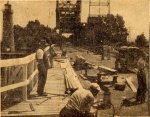The Hamilton Correspondent of the Toronto Globe wrote, in that paper's issue of 10 August,
"Since the Beach has become a place of public resort, the provision made by the Government for crossing the Burlington Canal by ferry, has become inadequate. The ferry was established over 20 years ago, when travel across the Beach was exceedingly limited and the ferryman's job was almost a sinecure. The Government regulations required the ferry to be at the free command of travellers from sunrise to sunset, but this is not sufficient to meet the requirements of the present day. It is true the ferryman, Mr. Joyce, does not refuse to take travellers over at earlier or later hours than those prescribed, but his labours are too great for one man to perform. It is stated that the average number of teams crossing in the summer is about 50 per day. For this work, Mr. Joyce receives $240.00 a year or 66 cents per day. It is true he has nothing to do during the winter, when the Bay is frozen over, but for five or six months in the year, his labour is enormous, nor can complaint be justly made because when called upon to ferry people after hours, he occasionally accepts a fee for this extra work. There can be no doubt that new regulations are necessary and it seems that the case need only be properly presented to the Government to induce it to comply with the demands of the public for increased facilities."
http://www.maritimehistoryofthegreatlakes.ca/documents/Brookes/default.asp?ID=Y1877
Scott,
What ‘government’ was this news paper article referring to? And, who, or what, was paying the ferryman $240 a year?




